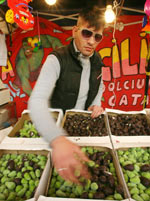“This is the food of the people of Sicily,” said Annalisa Spampinato, as the aroma of grilled quail, horsemeat and bacon-wrapped spring onions wafted through the night air in the town of Catania.
With crowds thronging the streets on the last night of the week-long Festa di Sant’Agata in honour of the local saint, Spampinato doled out Catania’s signature crispelle -handmade fritters that come in two styles, sticks of dough wrapped around anchovies, or balls of dough encasing ricotta cheese.
“It’s impossible to starve to death”
Served on thick Kraft paper, there is only one way to eat crispelle – hot. “Catania,” said olive-oil producer and intrepid Sicilian foodie Francesco Padova, “is one of the most important places in Italy for street food.” Agata, according to local legend, was the daughter of a noble family who rejected a family-made marriage and died devoted to God. “But in Catania it’s impossible to starve to death,” said Padova.
Under a blue neon light at Friggitoria Stella’s, where Spampinato works, the Stella family makes crispelle in three frying vats heated by giant gas flames. “When Saint Agnes is on, people come in here because it’s cold,” said Anna Stella, whose skill with a long-handled fry skimmer borders on the artistic.
“People heat themselves up with warm crispelle as they walk through the procession.” Anna suggests washing crispelle down with a bottle of Moretti beer, but for many, the crispelle come with a big dose of nostalgia.
“Everyone in town, grandfathers, fathers and children, comes here to eat,” said Allesandra Stella. “If you’re 80 years old, you come to remember your childhood.” “In Milan, you don’t get these things,” added Spampinato. “Even in Palermo, it’s different.” Crispelle fan and Italian food historian, Carmelo Spadaro di Passanitello, said much Italian street food has its origins in necessity.
“It’s typically food that’s a little too complicated to prepare at home,” he told AFP. “Fried food used to be something you would leave the house for. Even having an oven used to be dangerous.” And along with being tasty, anchovies, ricotta and onions were also cheap, he said. Also affordable were local specialties such as octopus, mussels and Catania’s fabled “zuzu” – a gelatinous mix of pigs’ ears, cheeks, noses and ears.
City’s most famous sgriccio kiosk
On Via Plebiscito, where street food junkies swallow the brunt of the late-night meals, hawkers hover over low rectangular grills stationed outside restaurants and butcher shops, Seemingly impervious to heat, cooks use stubby tongs or bare blackened hands to flip sausages, bacon-wrapped spring onions, breaded quail and horse steaks. They flick salt onto meat with a long-distance sidearm and brush it down with an olive oil, red vinegar and oregano vinaigrette.
There are big crowds outside Trattoria “Antico Corso” da Achille, where Achille himself runs the show, grilling trademark horse-steak sandwiches. Whatever some might think about eating horse, piled on a big bun and sloshed with vinaigrette, the sandwich seems the clear local favourite.
To wash it down, young locals like “sgriccio”, the Sicilan for “spritz” or “spray” – fountain and still-water drinks mixed with flavored syrups and Sicily’s native lemons. “The tradition began with sellers walking on the street, bringing the refreshment to the people,” said Angelo Giammona, one of six brothers who run Giammona, the city’s most famous sgriccio kiosk.
Mandarin syrup with a shot of real lemon and water was the wintertime favourite, he said, while in summer the biggest seller was “seltz e limone con sale” – seltzer water with lemon and salt. One peculiar tangy favourite was “tamarindo con bicorbonato e limone” – tamarind syrup with lemon and seltzer water. Once half-finished, the cups are set back onto the counter and Giammona stirs in a small scoop of sodium bicarbonate, which causes fizz to rise up to the rim.
“Tamarind is a perfect digestive and with the bicarbonate, it’s even more effective,” he said.
“For me, the tamarindo is a ritual. I can’t leave town without having one,” said olive oil producer Padova. “It’s like the shutters going down at the end of a meal. After that, I go home.”
Image: ITALY, Catania: A man sells Marzipan, a confection consisting primarily of sugar and ground almonds in the streets on the week-long Festa di Sant’Agata in honour of the local saint, Spampinato

